Progress in Research on Sustainable Urban Renewal Since 2000: Library and Visual Analyses
Abstract
1. Introduction
- the current performance of the publication in the diversity of sustainable urban renewal;
- the distribution of categories and thematic reviews in the variety of sustainable urban renewal;
- the contribution of countries and institutions to the diversity of sustainable urban renewal;
- the most influential authors on the topic of sustainable urban renewal and the most influential topics on urban renewal and sustainable development.
1.1. Urban Renewal
1.2. Urban Renewal and Sustainable Development
2. Methods/Data
2.1. Bibliometric Analysis
2.2. Impact Factor/H-Index
2.3. Data Sources
2.4. Bibliometric Analyses Results
2.4.1. Selected Publishing Performance
2.4.2. Distribution of Categories and Subject Reviews
2.4.3. Contribution by Country
2.4.4. The Contribution from Institutions
2.4.5. Author Analysis
3. Review of Existing Studies on Urban Renewal and Sustainability Cities
3.1. Thinking About Residential Mobility in Sustainable Urban Renewal
3.2. Social Change and Planning
4. Discussions and Innovations
4.1. Review of Studies Based on the Most Frequently Cited Articles and Key Research Areas
- The Role of Urban Parks for sustainable City
- Urbanization in developing countries: Current trends, future projections, and key challenges for sustainability
- Supilinn, Tartu—The lively vernacular against urban renewal: A Lefebvrean critique
- The changing metabolism of cities
- Rethinking sustainable cities: Multilevel governance and the ‘urban’ politics of climate change
- A SWOT analysis of the field of virtual reality rehabilitation and therapy
- The compact city fallacy
4.2. Evaluation of Sustainable Urban Renewal
4.3. Innovations
4.3.1. Evaluation and Analysis
4.3.2. The Various Stakeholders
4.3.3. Innovative Solutions
5. Conclusions
Author Contributions
Funding
Institutional Review Board Statement
Informed Consent Statement
Data Availability Statement
Conflicts of Interest
References
- Cobe, P. Urban renewal. Restaur. Bus. 2015, 114, 34. [Google Scholar]
- Donaldson, R.; Du Plessis, D. The urban renewal program as an area-based approach to renew townships: The experience from Khayelitsha’s Central Business District, Cape Town. Habitat Int. 2013, 39, 295–301. [Google Scholar] [CrossRef]
- Huang, L.; Zheng, W.; Hong, J.; Liu, Y.; Liu, G. Paths and strategies for sustainable urban renewal at the neighborhood level: A framework for decision-making. Sustain. Cities Soc. 2020, 55, 102074. [Google Scholar] [CrossRef]
- Adams, D.; Hastings, E.M. Urban renewal in Hong Kong: Transition from development corporation to renewal authority. Land Use Policy 2001, 18, 245–258. [Google Scholar] [CrossRef]
- Reimann, B. The transition from people’s property to private property: Consequences of the restitution principle for urban development and urban renewal in East Berlin’s inner-city residential areas. Appl. Geogr. 1997, 17, 301–313. [Google Scholar] [CrossRef]
- Lager, D.; Van Hoven, B.; Huigen, P.P.P. Dealing with change in old age: Negotiating working-class belonging in a neighborhood in the process of urban renewal in the Netherlands. Geoforum 2013, 50, 54–61. [Google Scholar] [CrossRef]
- In Proceedings of the International Symposium, New Metropolitan Perspectives, Reggio Calabria, Italy, 18–20 May 2017; Volume 1. New Metropolitan Perspectives. Available online: http://www.nmp.unirc.it/ (accessed on 6 April 2021).
- González-Bravo, R.; Marques, M.C.; Bezerra, M.O.; Coutinho, B.; del Castillo, J.L.; Vollmer, D.; Ramirez, A.I.; Mahlknecht, J. Urban sustainability: Analyzing the water-energy nexus in the Guandu river basin, Rio de Janeiro, Brazil. Energy Rep. 2020, 6, 254–260. [Google Scholar] [CrossRef]
- Sharifi, A. Urban sustainability assessment: An overview and bibliometric analysis. Ecol. Indic. 2021, 121, 107102. [Google Scholar] [CrossRef]
- He, F.; Wu, W.; Zhuang, T.; Yi, Y. Exploring the diverse expectations of stakeholders in industrial land redevelopment projects in China: The case of Shanghai. Sustainability 2019, 11, 4744. [Google Scholar] [CrossRef]
- Yang, Z.; Yang, H.; Wang, H. Evaluating urban sustainability under different development pathways: A case study of the Beijing-Tianjin-Hebei region. Sustain. Cities Soc. 2020, 61, 102226. [Google Scholar] [CrossRef]
- Ahern, J. From fail-safe to safe-to-fail: Sustainability and resilience in the new urban world. Landsc. Urban Plan. 2011, 100, 341–343. [Google Scholar] [CrossRef]
- Carvalho, J.P.; Bragança, L.; Mateus, R. Sustainable building design: Analysing the feasibility of BIM platforms to support practical building sustainability assessment. Comput. Ind. 2021, 127, 103400. [Google Scholar] [CrossRef]
- Wang, H.; Shen, Q.; Tang, B.; Lu, C.; Peng, Y.; Tang, L. A framework of decision-making factors and supporting information for facilitating sustainable site planning in urban renewal projects. Cities 2014, 40, 44–55. [Google Scholar] [CrossRef]
- Ameen, R.F.M.; Mourshed, M. Urban sustainability assessment framework development: The ranking and weighting of sustainability indicators using analytic hierarchy process. Sustain. Cities Soc. 2019, 44, 356–366. [Google Scholar] [CrossRef]
- New Urban Agenda. Available online: https://habitat3.org/the-new-urban-agenda/preparatory-process/national-participation/kenya/ (accessed on 6 April 2021).
- Du, X.; Zhang, X.; Wang, H.; Zhi, X.; Huang, J. Assessing green space potential accessibility through urban artificial building data in Nanjing, China. Sustainability 2020, 12, 9935. [Google Scholar] [CrossRef]
- Wang, H.; Shen, Q.; Tang, B.S.; Skitmore, M. An integrated approach to supporting land-use decisions in site redevelopment for urban renewal in Hong Kong. Habitat Int. 2013, 38, 70–80. [Google Scholar] [CrossRef]
- Yataganbaba, A.; Ozkahraman, B.; Kurtbas, I. Worldwide trends on encapsulation of phase change materials: A bibliometric analysis (1990–2015). Appl. Energy 2017, 185, 720–731. [Google Scholar] [CrossRef]
- Tang, M.; Hong, J.; Wang, X.; He, R. Sustainability accounting of neighborhood metabolism and its applications for urban renewal based on emergy analysis and SBM-DEA. J. Environ. Manag. 2020, 275, 111177. [Google Scholar] [CrossRef]
- Macke, J.; Rubim Sarate, J.A.; de Atayde Moschen, S. Smart sustainable cities evaluation and sense of community. J. Clean. Prod. 2019, 239, 118103. [Google Scholar] [CrossRef]
- Yıldız, S.; Kıvrak, S.; Gültekin, A.B.; Arslan, G. Built environment design—Social sustainability relation in urban renewal. Sustain. Cities Soc. 2020, 60, 102173. [Google Scholar] [CrossRef]
- Bello, V.; Nwosu, A. Effects of urban renewal on residential property values in two neighborhoods of Akure, Ni. FUTY J. Environ. 2012, 6. [Google Scholar] [CrossRef]
- Mao, G.; Liu, X.; Du, H.; Zuo, J.; Wang, L. Way forward for alternative energy research: A bibliometric analysis during 1994–2013. Renew. Sustain. Energy Rev. 2015, 48, 276–286. [Google Scholar] [CrossRef]
- Yang, J.; Vannier, M.W.; Wang, F.; Deng, Y.; Ou, F.; Bennett, J.; Liu, Y.; Wang, G. A bibliometric analysis of academic publication and NIH funding. J. Informetr. 2013, 7, 318–324. [Google Scholar] [CrossRef]
- Cobo, M.J.; Martínez, M.A.; Gutiérrez-Salcedo, M.; Fujita, H.; Herrera-Viedma, E. 25 years at knowledge-based systems: A bibliometric analysis. Knowl. Based Syst. 2015, 80, 3–13. [Google Scholar] [CrossRef]
- Yataganbaba, A.; Kurtbaş, I. A scientific approach with bibliometric analysis related to brick and tile drying: A review. Renew. Sustain. Energy Rev. 2016, 59, 206–224. [Google Scholar] [CrossRef]
- Beck, J.; Chiapello, L. Schön’s intellectual legacy: A citation analysis of DRS publications (2010–2016). Des. Stud. 2018, 56, 205–224. [Google Scholar] [CrossRef]
- Deboin, M.C.; Fovet-Rabot, C.; Lambert, M.C. Le Facteur D’impact (FI) et ses Indicateurs Associés Pour Evaluer la Notoriété, D’une Revue en 7 Points; CoopIST Cirad: Montpellier, France, 2017; pp. 1–5. [Google Scholar]
- Ranjan, C.K. Bibliometric indices of scientific journals: Time to overcome the obsession and think beyond the impact factor. Med. J. Armed Forces India 2017, 73, 175–177. [Google Scholar] [CrossRef]
- Jones, A.W. Impact factors of forensic science and toxicology journals: What do the numbers really mean? Forensic. Sci. Int. 2003, 133, 1–8. [Google Scholar] [CrossRef]
- Chen, W.; Liu, W.; Geng, Y.; Brown, M.T.; Gao, C.; Wu, R. Recent progress on emergy research: A bibliometric analysis. Renew. Sustain. Energy Rev. 2017, 73, 1051–1060. [Google Scholar] [CrossRef]
- Wang, L.; Wei, Y.M.; Brown, M.A. Global transition to low-carbon electricity: A bibliometric analysis. Appl. Energy 2017, 205, 57–68. [Google Scholar] [CrossRef]
- Zheng, H.W.; Shen, G.Q.; Wang, H. A review of recent studies on sustainable urban renewal. Habitat Int. 2014, 41, 272–279. [Google Scholar] [CrossRef]
- Valeriu, I.; Ristea, A. Commercial Facilities and Urban Regeneration. Amfiteatru Econ. J. 2010, 12, 99–114. [Google Scholar]
- Chiesura, A. The role of urban parks for the sustainable city. Landsc. Urban Plan. 2004, 68, 129–138. [Google Scholar] [CrossRef]
- Cohen, B. Urbanization in developing countries: Current trends, future projections, and key challenges for sustainability. Technol. Soc. 2006, 28, 63–80. [Google Scholar] [CrossRef]
- Tan, Y.; Xu, H.; Zhang, X. Sustainable urbanization in China: A comprehensive literature review. Cities 2016, 55, 82–93. [Google Scholar] [CrossRef]
- Sukmana, N.A.; Yuliastuti, N. Government effort through urban renewal for maintaining cultural heritage areas in Old City Semarang. IOP Conf. Ser. Earth Environ. Sci. 2020, 409. [Google Scholar] [CrossRef]
- Kirszbaum, T. Mobilité Résidentielle et Mixité Urbaine: Les Conditions d’une Politique Equitable; HAL Open Archive: Lyon, France, 2014. [Google Scholar]
- Battisti, A.; Barnocchi, A.; Iorio, S. Urban regeneration process: The case of a residential complex in a suburb of Rome, Italy. Sustainability 2019, 11, 6122. [Google Scholar] [CrossRef]
- Neto, L.; Pinto, N.; Burns, M. Evaluating the impacts of urban regeneration companies in Portugal: The case of Porto. Plan. Pract. Res. 2014, 29, 525–542. [Google Scholar] [CrossRef]
- Nutt, N.; Hiob, M.; Kotval, Z. Supilinn, Tartu—The lively vernacular against urban renewal: A Lefebvrean critique. Space Cult. 2016, 19, 332–344. [Google Scholar] [CrossRef]
- Serrano-Jiménez, A.; Lima, M.L.; Molina-Huelva, M.; Barrios-Padura, Á. Promoting urban regeneration and aging in place: APRAM—An interdisciplinary method to support decision-making in building renovation. Sustain. Cities Soc. 2019, 47, 101505. [Google Scholar] [CrossRef]
- Cities, S.; Huelva, M.; Cities, S. Repositório ISCTE-IUL; Instituto Universitario de Lisboa: Lisbon, Portugal, 2019. [Google Scholar]
- Kennedy, C.; Cuddihy, J.; Engel-Yan, J. The changing metabolism of cities. J. Ind. Ecol. 2007, 11, 43–59. [Google Scholar] [CrossRef]
- Karimi, A.; Yazdandad, H.; Fagerholm, N. Evaluating social perceptions of ecosystem services, biodiversity, and land management: Trade-Offs, synergies and implications for landscape planning and management. Ecosyst. Serv. 2020, 45, 101188. [Google Scholar] [CrossRef]
- Aksnes, D.W. Characteristics of highly cited papers. Res. Eval. 2003, 12, 159–170. [Google Scholar] [CrossRef]
- Bulkeley, H.; Betsill, M.M. Rethinking sustainable cities: Multilevel governance and the “urban” politics of climate change. Environ. Politics 2005, 14, 42–63. [Google Scholar] [CrossRef]
- Rizzo, A.; Kim, G.J. A SWOT analysis of the field of virtual reality rehabilitation and therapy. Presence Teleoper. Virtual Environ. 2005, 14, 119–146. [Google Scholar] [CrossRef]
- Neuman, M. The compact city fallacy. J. Plan. Educ. Res. 2005, 25, 11–26. [Google Scholar] [CrossRef]
- Gou, Z.; Xie, X.; Lu, Y.; Khoshbakht, M. Quality of life (QoL) survey in Hong Kong: Understanding the importance of housing environment and needs of residents from different housing sectors. Int. J. Environ. Res. Public Health 2018, 15, 219. [Google Scholar] [CrossRef]
- Maya Jariego, I. Sentido de comunidad y potenciación comunitaria. Miríada Investig. Cienc. Soc. 2009, 2, 69–109. [Google Scholar]
- Jim, C.Y.; Chan, M.W.H. Urban greenspace delivery in Hong Kong: Spatial-Institutional limitations and solutions. Urban For. Urban Green. 2016, 18, 65–85. [Google Scholar] [CrossRef]
- Boulton, C.; Dedekorkut-Howes, A.; Holden, M.; Byrne, J. Under pressure: Factors shaping urban greenspace provision in a mid-sized city. Cities 2020, 106, 102816. [Google Scholar] [CrossRef]
- Fernández, K.G.; Moreno-Calles, A.I.; Casas, A.; Blancas, J. Contributions of urban collective gardens to local sustainability in Mexico City. Sustainability 2020, 12, 7562. [Google Scholar] [CrossRef]
- Ferris, J.; Norman, C.; Sempik, J. People, land and sustainability: Community gardens and the social dimension of sustainable development. Soc. Policy Adm. 2020, 9515. [Google Scholar] [CrossRef]
- Tappert, S.; Klöti, T.; Drilling, M. Contested urban green spaces in the compact city: The (re-) negotiation of urban gardening in Swiss cities. Landsc. Urban Plan. 2020, 170, 2020. [Google Scholar] [CrossRef]
- Heikinheimo, V.; Tenkanen, H.; Bergroth, C.; Järv, O.; Hiippala, T.; Toivonen, T. Understanding the use of urban green spaces from user-generated geographic information. Landsc. Urban Plan. 2020, 201, 103845. [Google Scholar] [CrossRef]
- Gong, F.; Zheng, Z.-C.; Ng, E. Modeling elderly accessibility to urban green space in high-density cities: A case study of Hong Kong. Procedia Environ. Sci. 2016, 36, 90–97. [Google Scholar] [CrossRef]
- Nasehi, S.; Imanpour Namin, A. Assessment of urban green space fragmentation using landscape metrics (case study: District 2, Tehran city). Model. Earth Syst. Environ. 2020, 6, 2405–2414. [Google Scholar] [CrossRef]
- Veyret, Y. Villes et Développements Durables. Actes du Séminaire Natl. Villes Développements Durables; La Direction Générale de L’enseignement Scolaire (DGESCO): Paris, France, 2007; pp. 20–32. [Google Scholar]
- National Research Council. How People Learn: Brain, Mind, Experience, and School; National Academy of Sciences: Washington, DC, USA, 2005. [Google Scholar]
- Rana, M.M.P. Urbanization and sustainability: Challenges and strategies for sustainable urban development in Bangladesh. Environ. Dev. Sustain. 2011, 13, 237–256. [Google Scholar] [CrossRef]
- Egidi, G.; Salvati, L.; Vinci, S. The long way to Tipperary: City size and worldwide urban population trends, 1950–2030. Sustain. Cities Soc. 2020, 60, 102148. [Google Scholar] [CrossRef]
- Grossetti, M. Powered by TCPDF (www.tcpdf.org) 1/1. How Lang. Learn. 2013, 12, 27–40. [Google Scholar]
- Telles, J.A. Learning foreign languages in teletandem: Resources and strategies. DELTA Doc. Estud. Linguist. Teor. Apl. 2015, 31, 603–632. [Google Scholar] [CrossRef][Green Version]
- Ročak, M.; Hospers, G.J.; Reverda, N. Searching for social sustainability: The case of the shrinking city of Heerlen, The Netherlands. Sustainability 2016, 8, 382. [Google Scholar] [CrossRef]
- Brorström, S. Strategizing sustainability: The case of River City, Gothenburg. Cities 2015, 42, 25–30. [Google Scholar] [CrossRef]
- Haase, A.; Rink, D.; Grossmann, K.; Bernt, M.; Mykhnenko, V. Conceptualizing urban shrinkage. Environ. Plan. A 2014, 46, 1519–1534. [Google Scholar] [CrossRef]
- Arizaga, X. Ambiances et rénovation urbaine. Santiago du Chili, trois quartiers, un siècle: 1910–2010. In Proceedings of the 3rd International Congress on Ambiances, Volos, Greece, 21–24 September 2016. [Google Scholar]
- Hiob, M.; Nutt, N.; Nurme, S.; De Luca, F. Risen from the dead: From slumming to gentrification. Transilv. Rev. Adm. Sci. 2012, 8, 92–105. [Google Scholar]
- Lyons, G.; Mokhtarian, P.; Dijst, M.; Böcker, L. The dynamics of urban metabolism in the face of digitalization and changing lifestyles: Understanding and influencing our cities. Resour. Conserv. Recycl. 2018, 132, 246–257. [Google Scholar] [CrossRef]
- Wang, X.; Zhang, Y.; Zhang, J.; Fu, C.; Zhang, X. Progress in urban metabolism research and hotspot analysis based on CiteSpace analysis. J. Clean. Prod. 2020, 281, 125224. [Google Scholar] [CrossRef]
- Dai, T.; Liu, R. Dematerialization in Beijing from the perspective of material metabolism. J. Clean. Prod. 2018, 201, 792–801. [Google Scholar] [CrossRef]
- Lienemann, M.-N. The Section for Sustainable Management of Territories. Assessment and Outlook for the National Urban Regeneration Plan (ANRU Action). Closing the Gap in Housing Provision and Better Distribution of Social Housing in Order; Conseil Économique Social et Environnemental: Paris, France, 2013; Volume 33. [Google Scholar]
- Currie, P.K.; Musango, J.K.; May, N.D. Urban metabolism: A review with reference to Cape Town. Cities 2017, 70, 91–110. [Google Scholar] [CrossRef]
- Bulkeley, H. Urban sustainability: Learning from best practice? Environ. Plan. A 2006, 38, 1029–1045. [Google Scholar] [CrossRef]
- Engelbrecht, H.; Lindeman, R.W.; Hoermann, S. A SWOT analysis of the field of virtual reality for firefighter training. Front. Robot. AI 2019, 6, 1–14. [Google Scholar] [CrossRef]
- Jiang, R.; Mao, C.; Hou, L.; Wu, C.; Tan, J. A SWOT analysis for promoting off-site construction under the backdrop of China’s new urbanization. J. Clean. Prod. 2018, 173, 225–234. [Google Scholar] [CrossRef]
- Ilieva, L. Better governance of urban mobility by exchange of experience and evaluation of best practices. Transp. Res. Procedia 2019, 41, 37–40. [Google Scholar] [CrossRef]
- Andres, L.; Bochet, B. Ville durable, ville mutable: Quelle convergence en France et en Suisse? Rev. Écon. Rég. Urbaine 2010, 4, 729. [Google Scholar] [CrossRef]
- Thierry, C.; Antoni, J.-P. Renouvellement urbain et ville compacte: Modélisation et évaluation de la réhabilitation d’ouvrages lourds pour une urbanisation plus durable. In Proceedings of the 12ièmes Rencontres de ThéoQuant, Besançon, France, 20–22 May 2015; pp. 1–23. [Google Scholar]
- Wang, Y.; Li, J.; Zhang, G.; Li, Y.; Henry, M. Fuzzy evaluation of comprehensive benefit in urban renewal based on the perspective of core stakeholders. Habitat Int. 2017, 66, 163–170. [Google Scholar] [CrossRef]
- Chiu, Y.; Lee, M.; Wang, J. Culture-Led urban regeneration strategy: An evaluation of the management strategies and performance of urban regeneration stations in Taipei City. Habitat Int. 2019, 86, 1–9. [Google Scholar] [CrossRef]
- Chahardowli, M.; Sajadzadeh, H.; Aram, F.; Mosavi, A. Survey of sustainable regeneration of historic and cultural cores of cities. Energies 2020, 13, 2708. [Google Scholar] [CrossRef]
- Liberati, A.; Altman, D.G.; Tetzlaff, J.; Mulrow, C.; Gøtzsche, P.C.; Ioannidis, J.P.A.; Clarke, M.; Devereaux, P.J.; Kleijnen, J.; Moher, D. The PRISMA statement for reporting systematic reviews and meta-analyses of studies that evaluate healthcare interventions: Explanation and elaboration. BMJ 2009, 339. [Google Scholar] [CrossRef] [PubMed]
- Munoz, F. Lock living: Urban sprawl in Mediterranean cities. Cities 2003, 20, 381–385. [Google Scholar] [CrossRef]
- Lai, L.W.C.; Lorne, F.T. Sustainable urban renewal and built heritage conservation in a global real estate revolution. Sustainability 2019, 11, 850. [Google Scholar] [CrossRef]
- Versaci, A. The evolution of urban heritage concept in France, between conservation and rehabilitation programs. Procedia Soc. Behav. Sci. 2016, 225, 3–14. [Google Scholar] [CrossRef]
- Zheng, W.; Shen, G.Q.; Wang, H.; Hong, J.; Li, Z. Decision support for sustainable urban renewal: A multi-scale model. Land Use Policy 2017, 69, 361–371. [Google Scholar] [CrossRef]
- Antoine-Laurent de Lavoisier, The chimical revolution. In An International Historic Chemical Landmark; American Chemical Society, 1998; Available online: https://www.acs.org/content/acs/en/education/whatischemistry/landmarks/lavoisier.html (accessed on 6 April 2021).
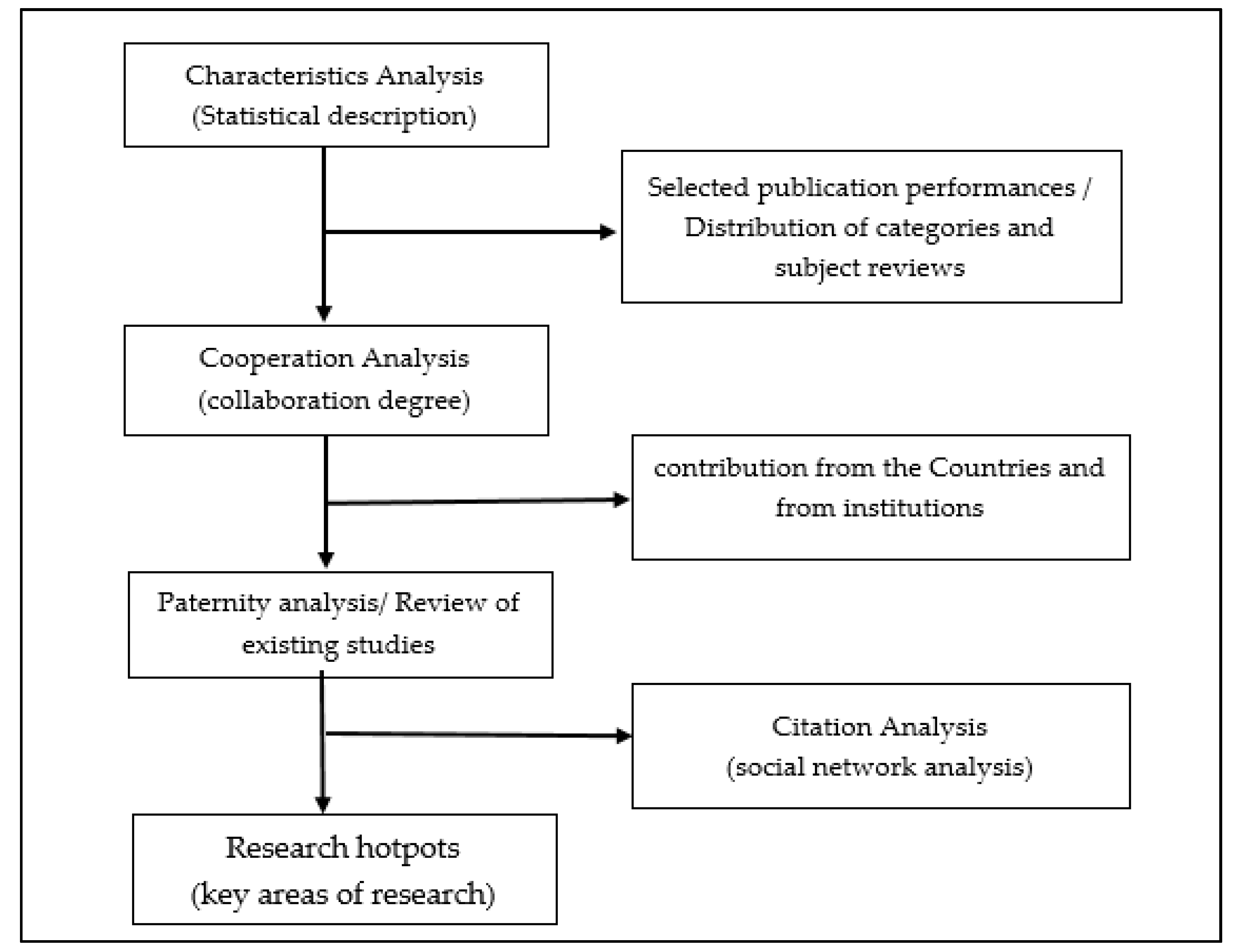
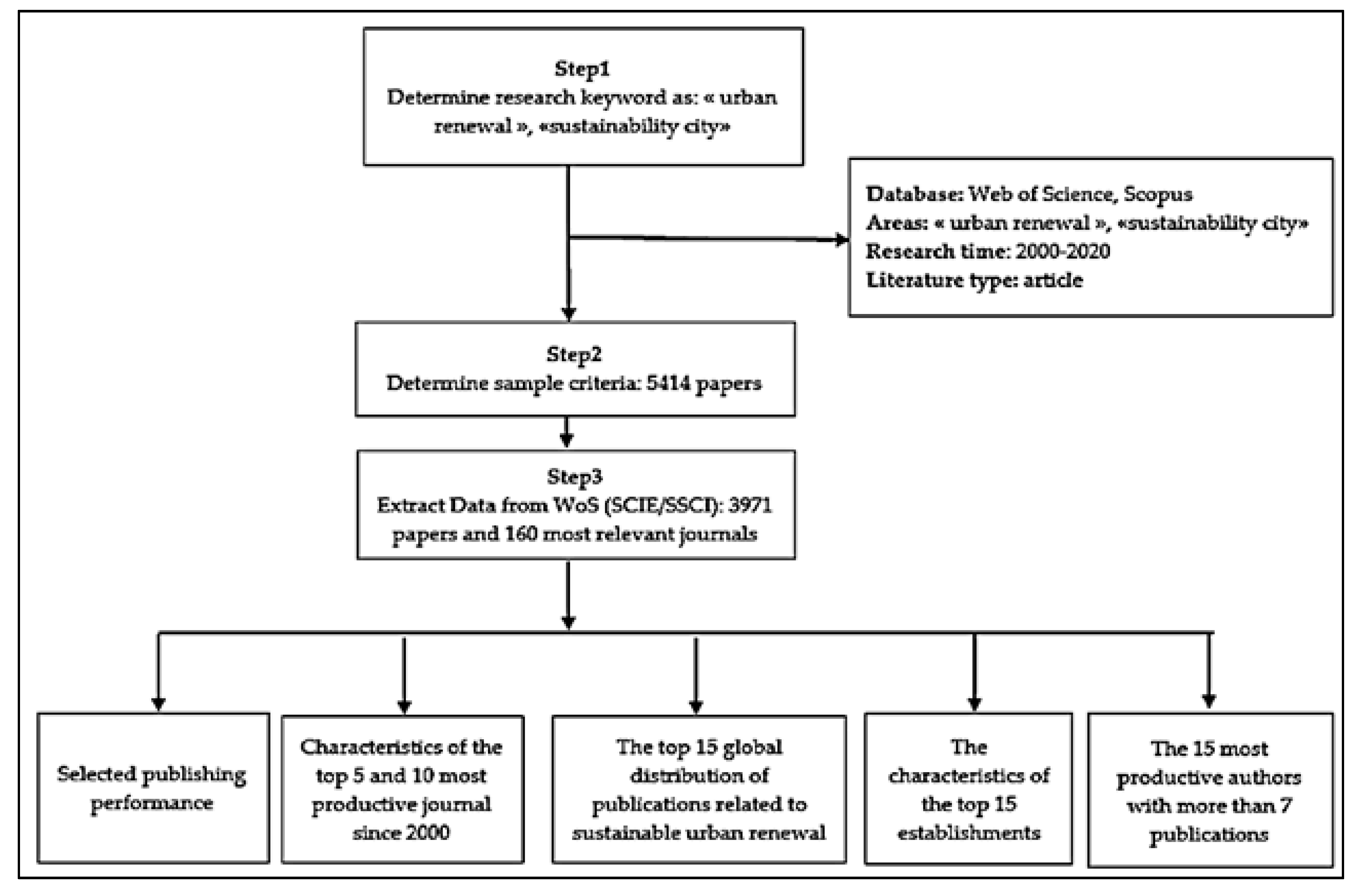
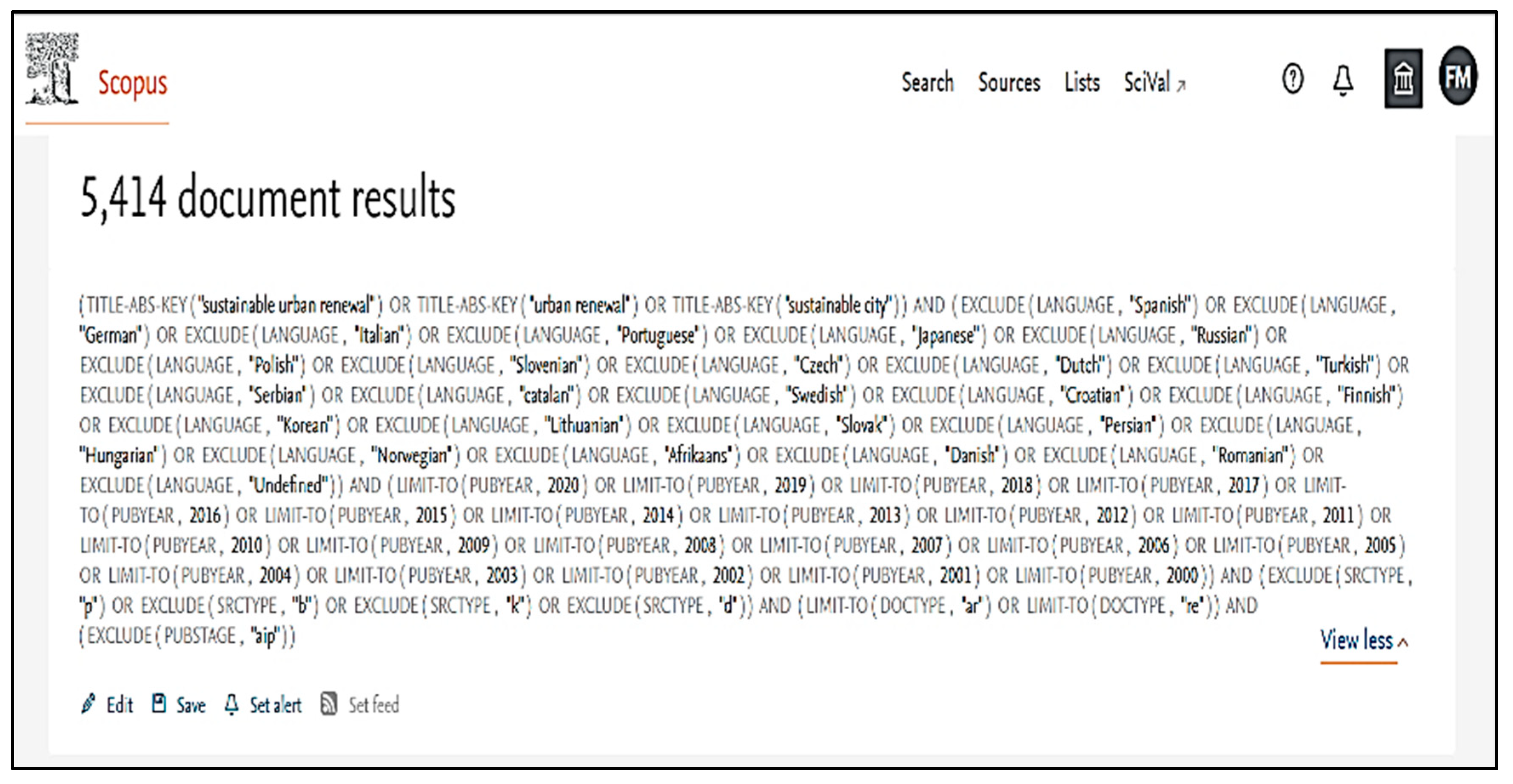
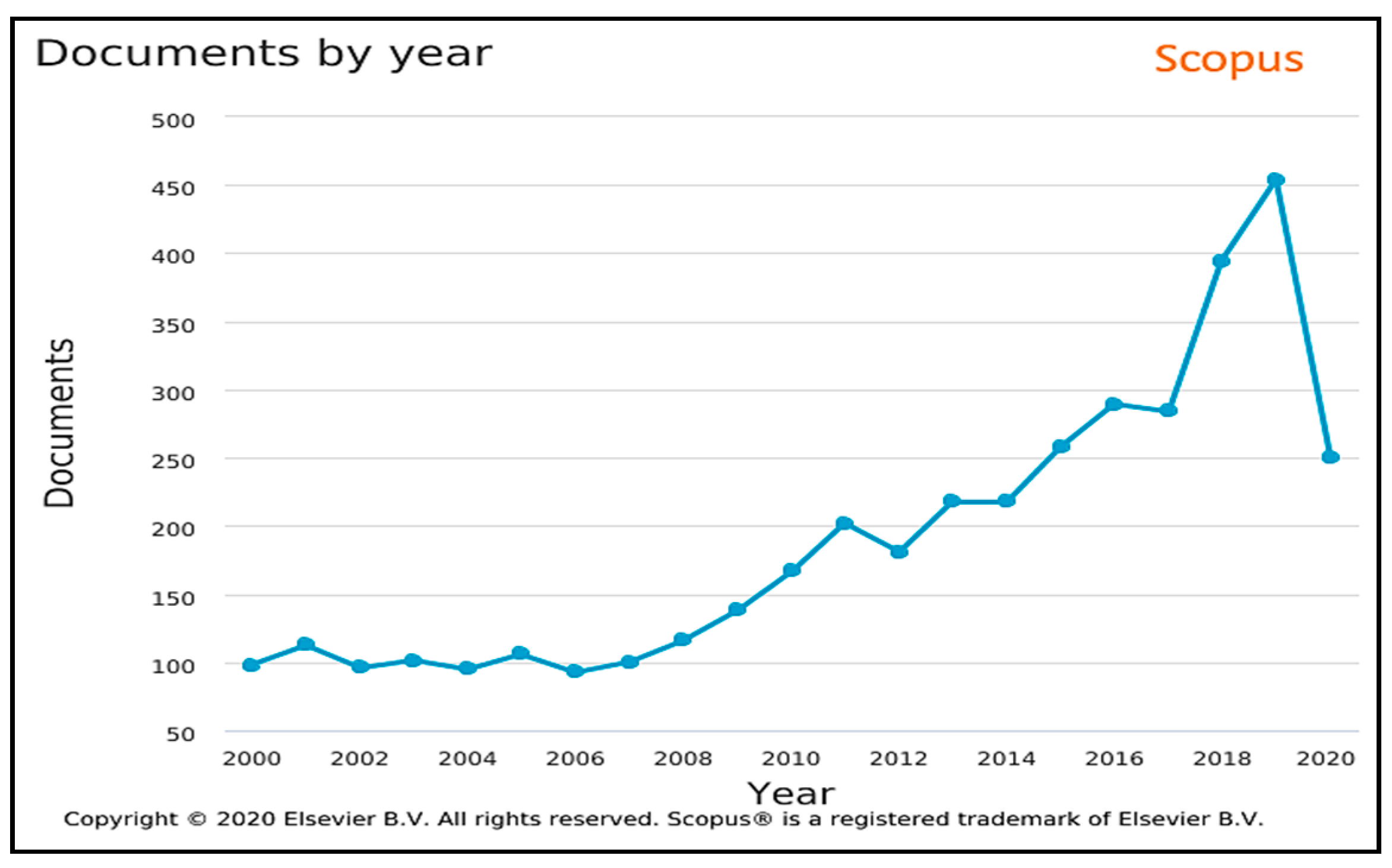
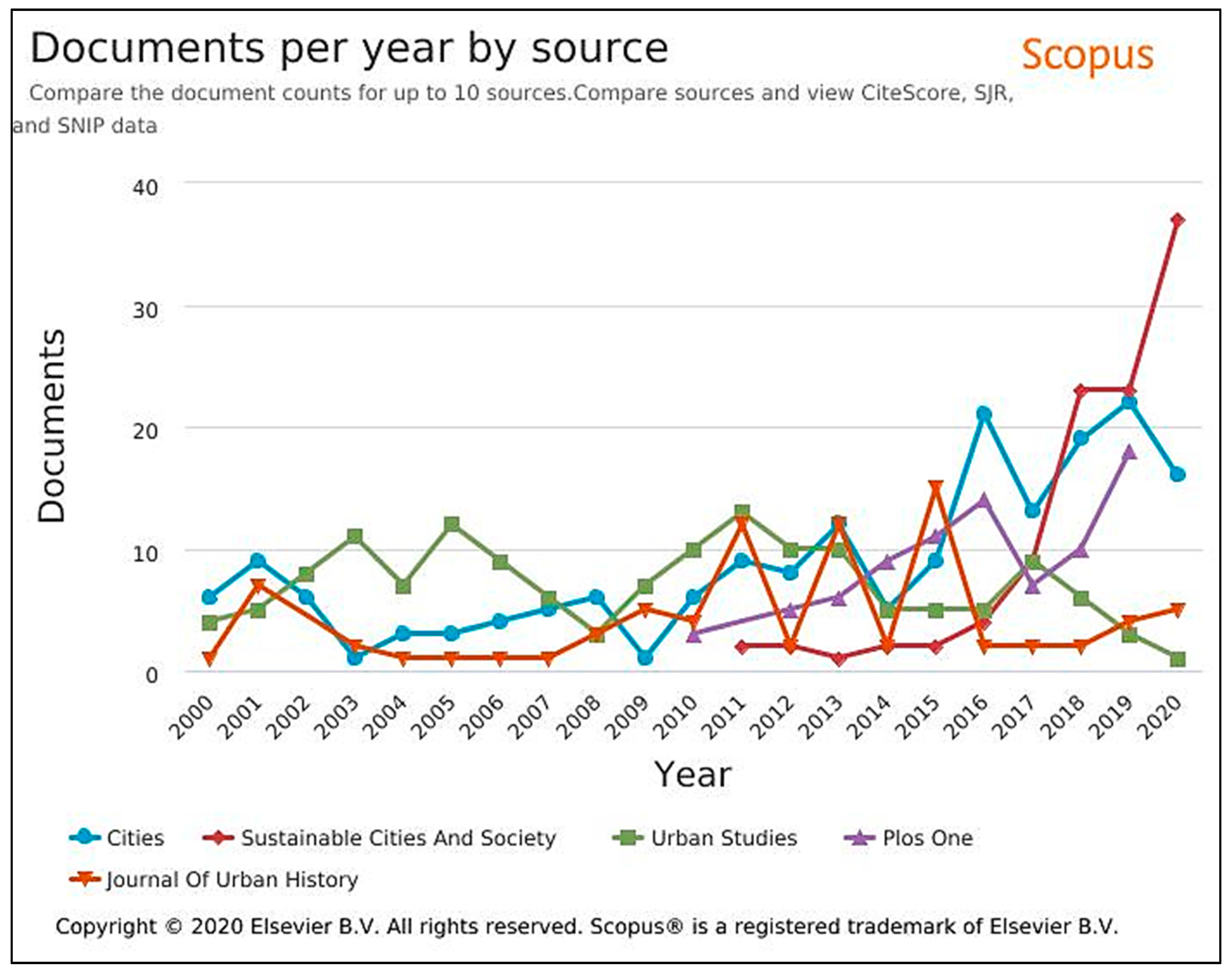
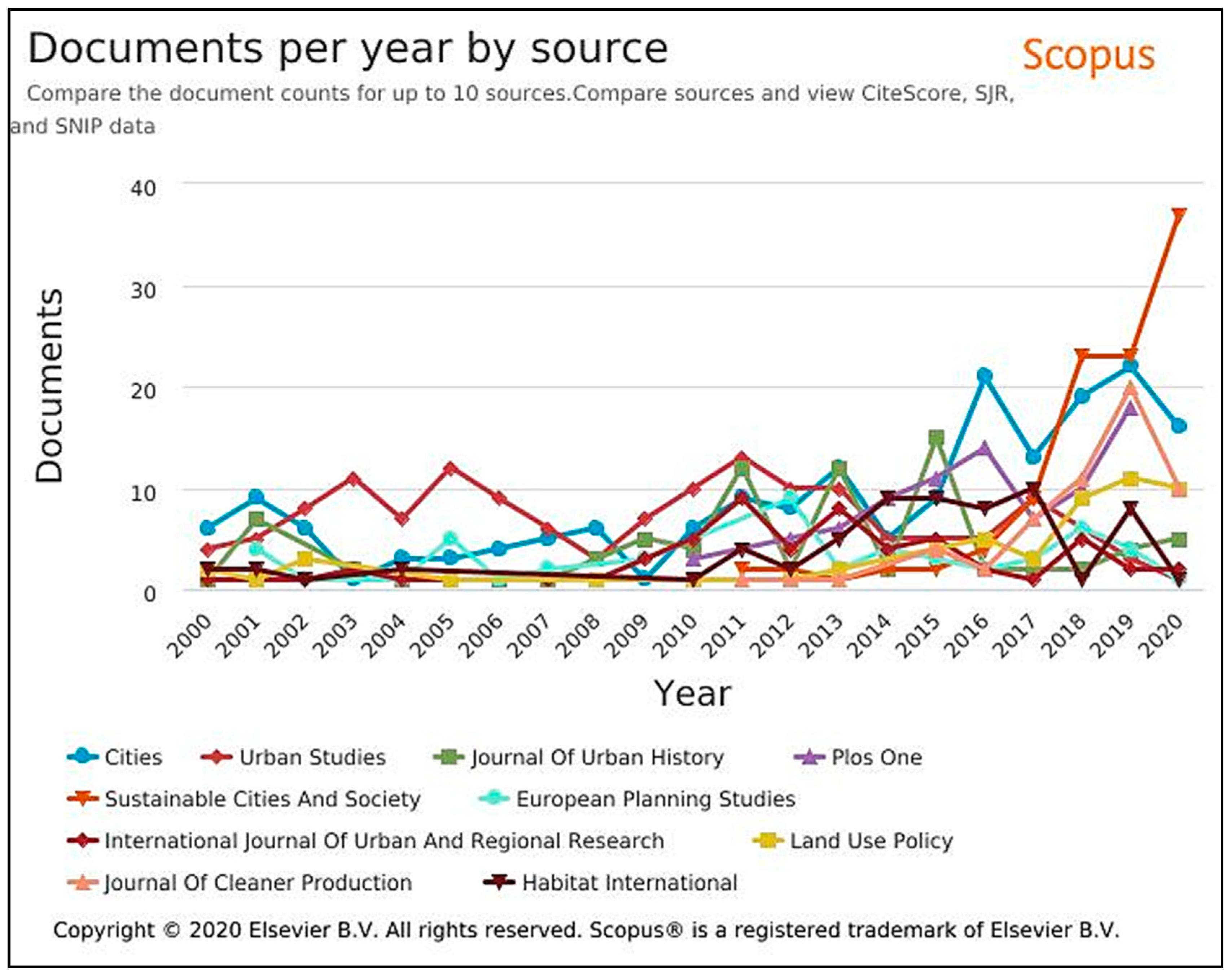
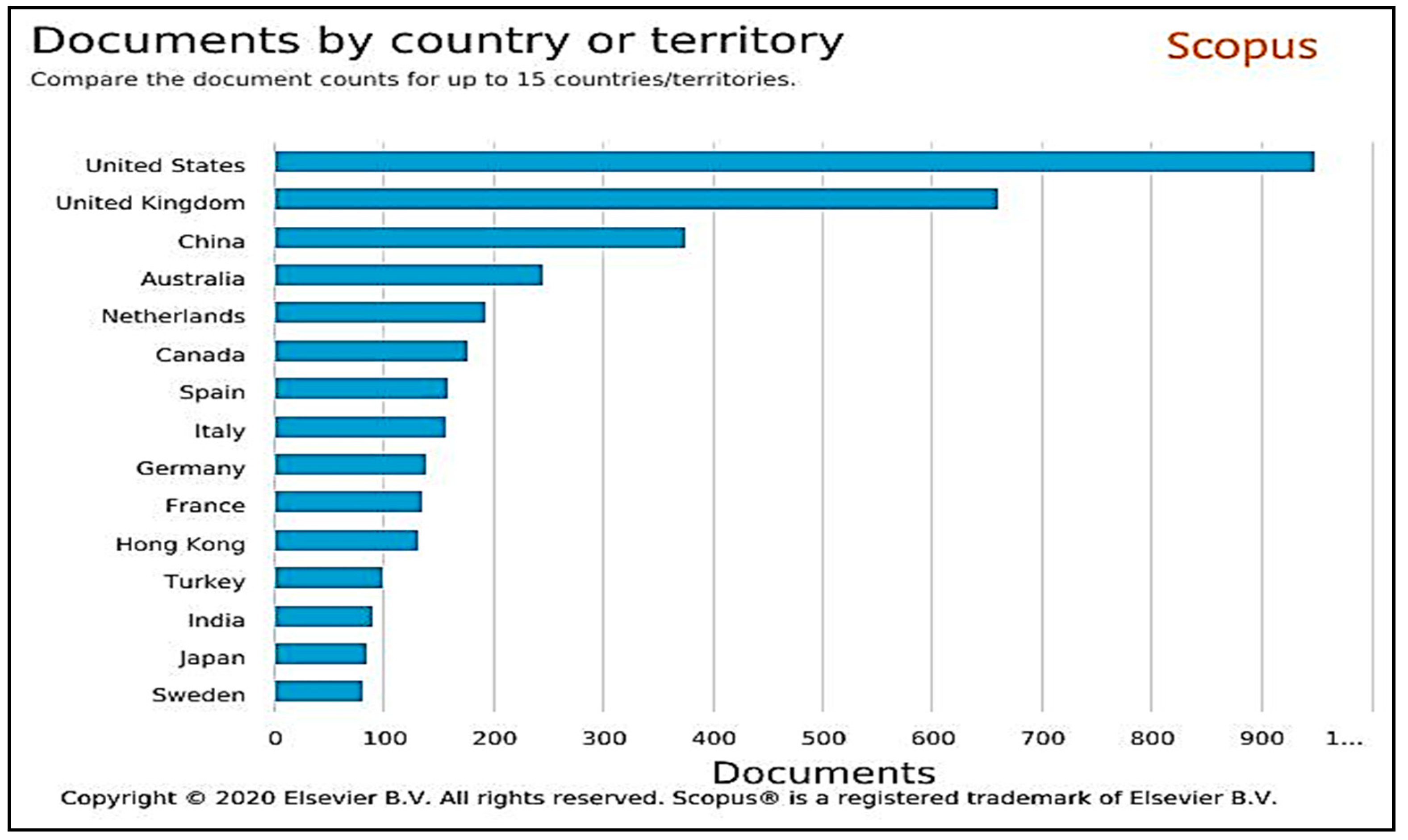
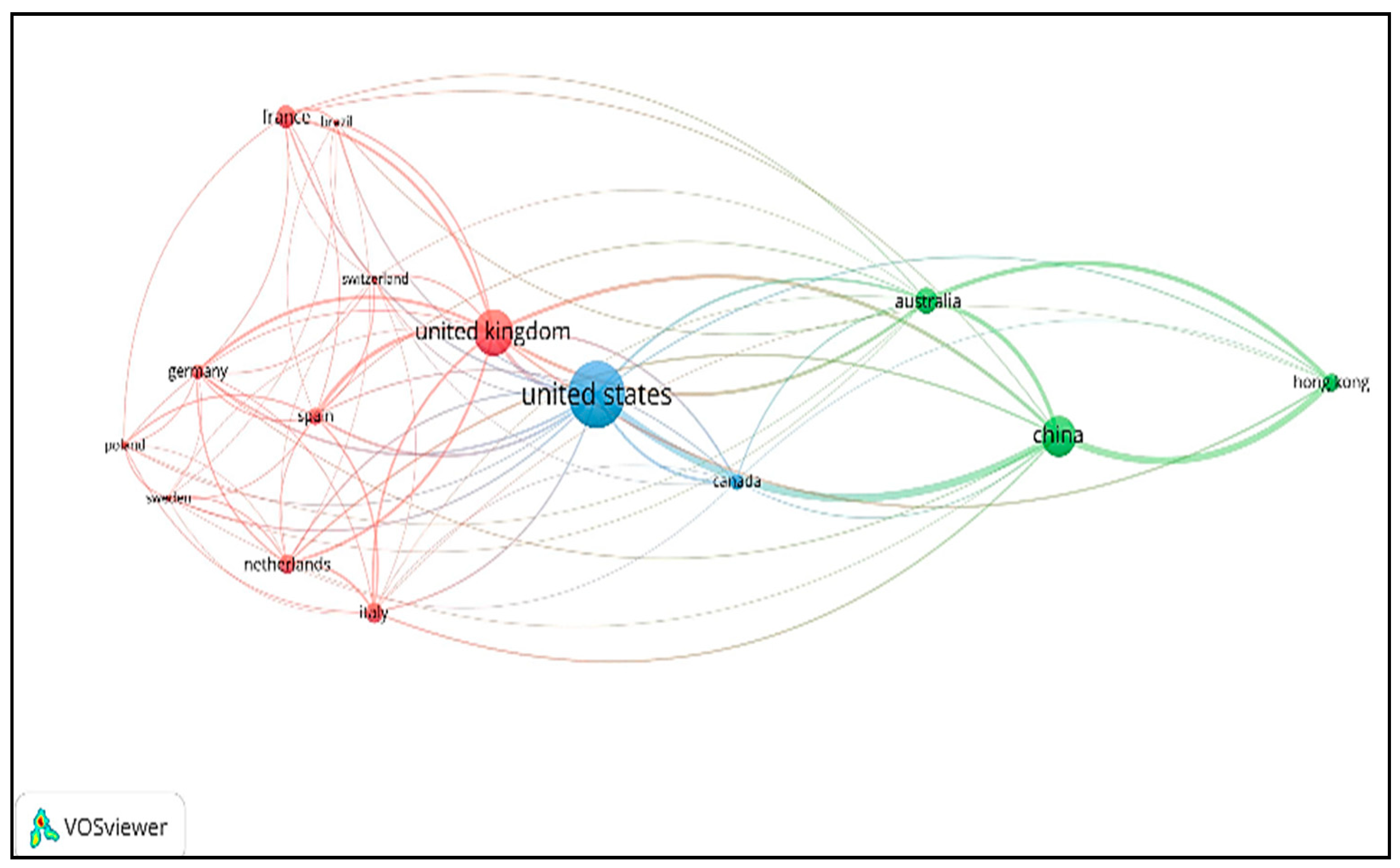
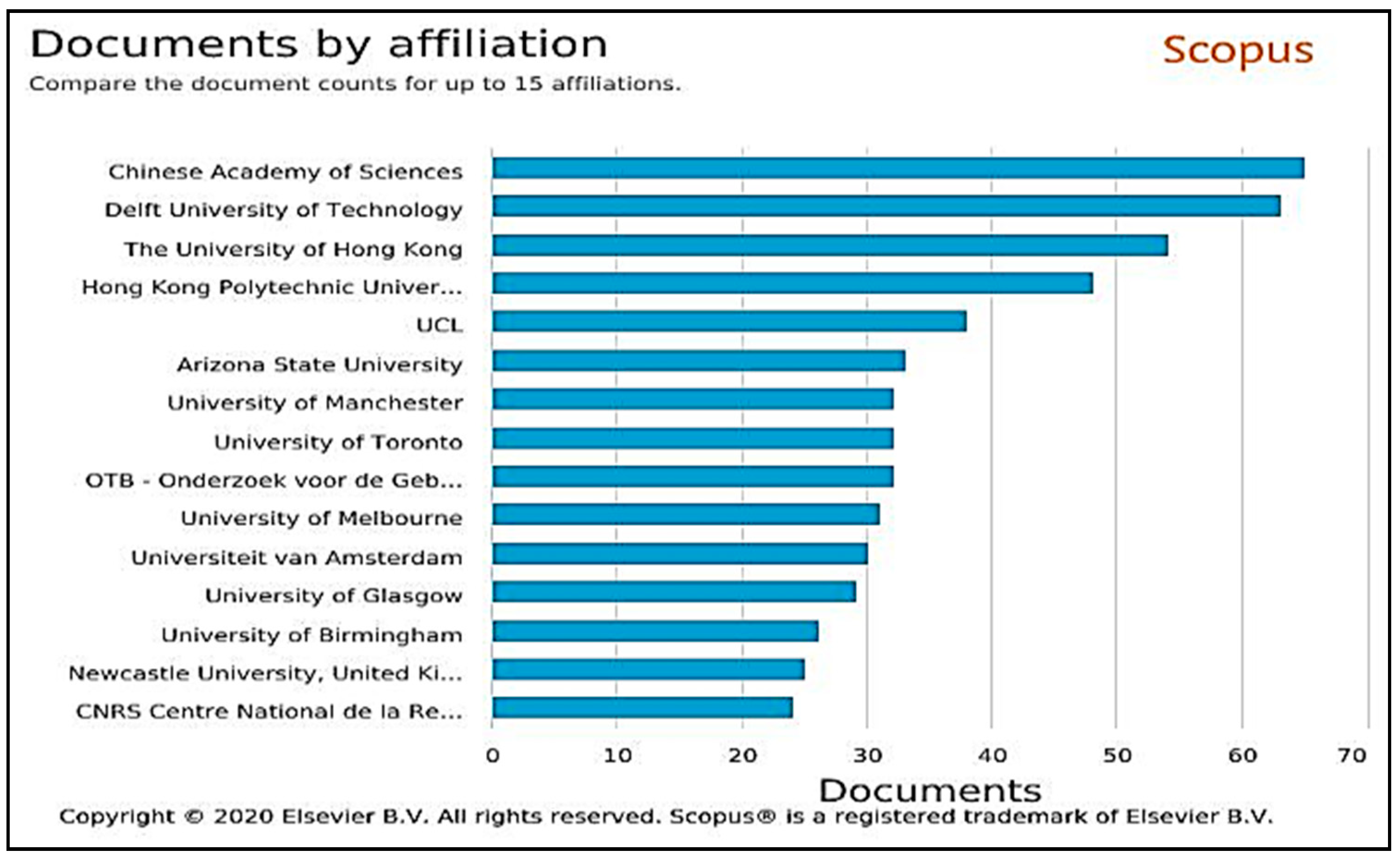

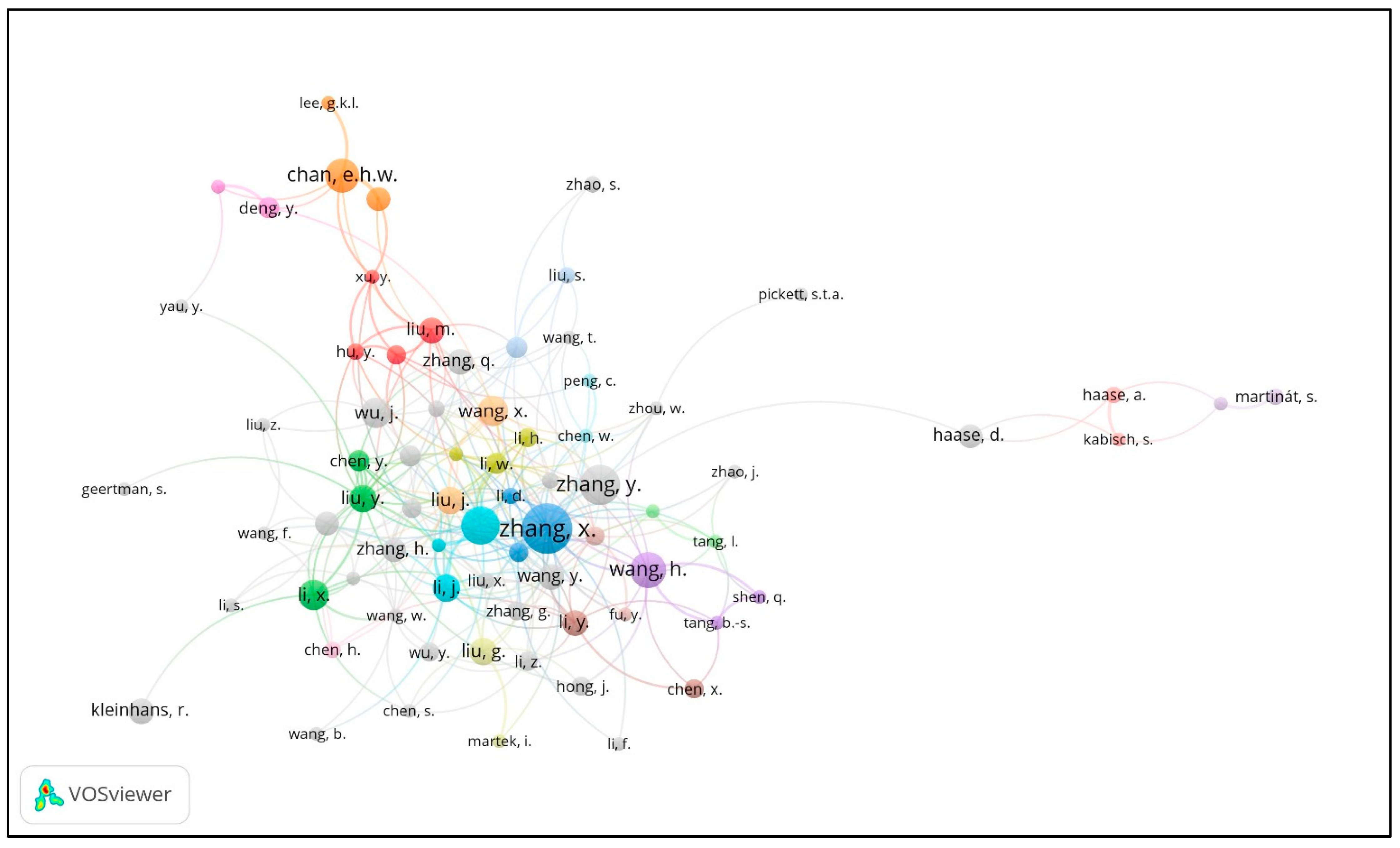
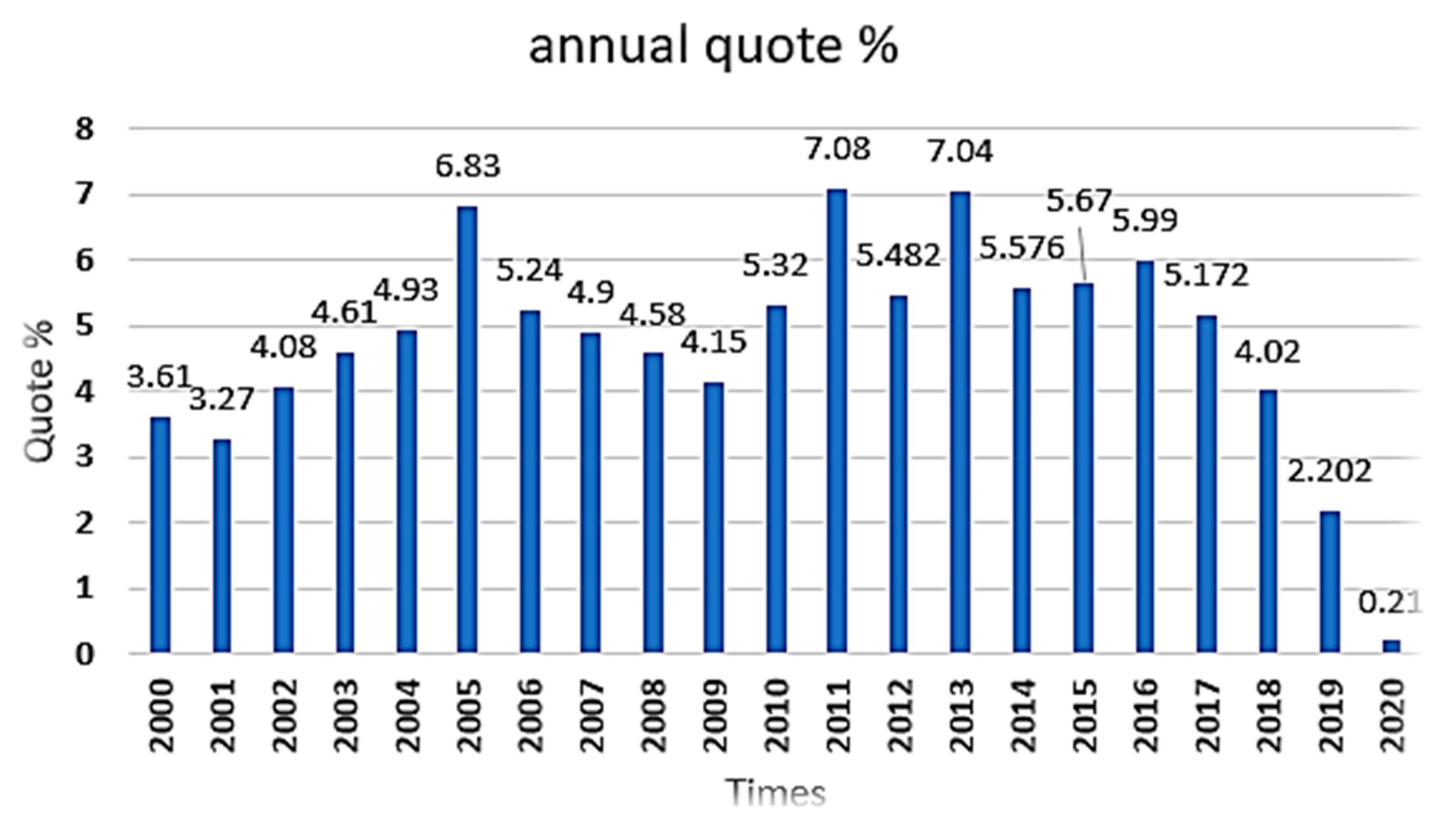
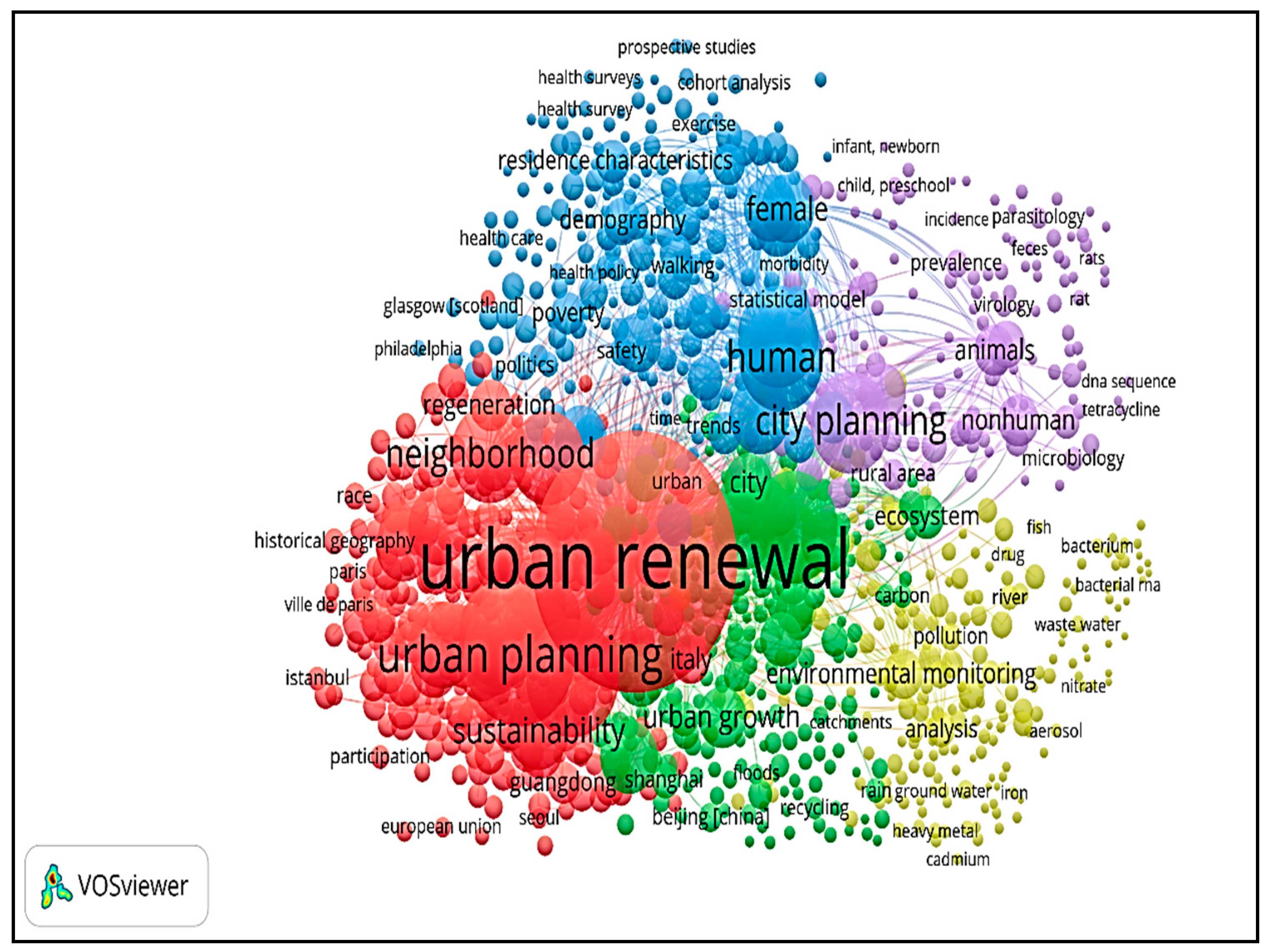
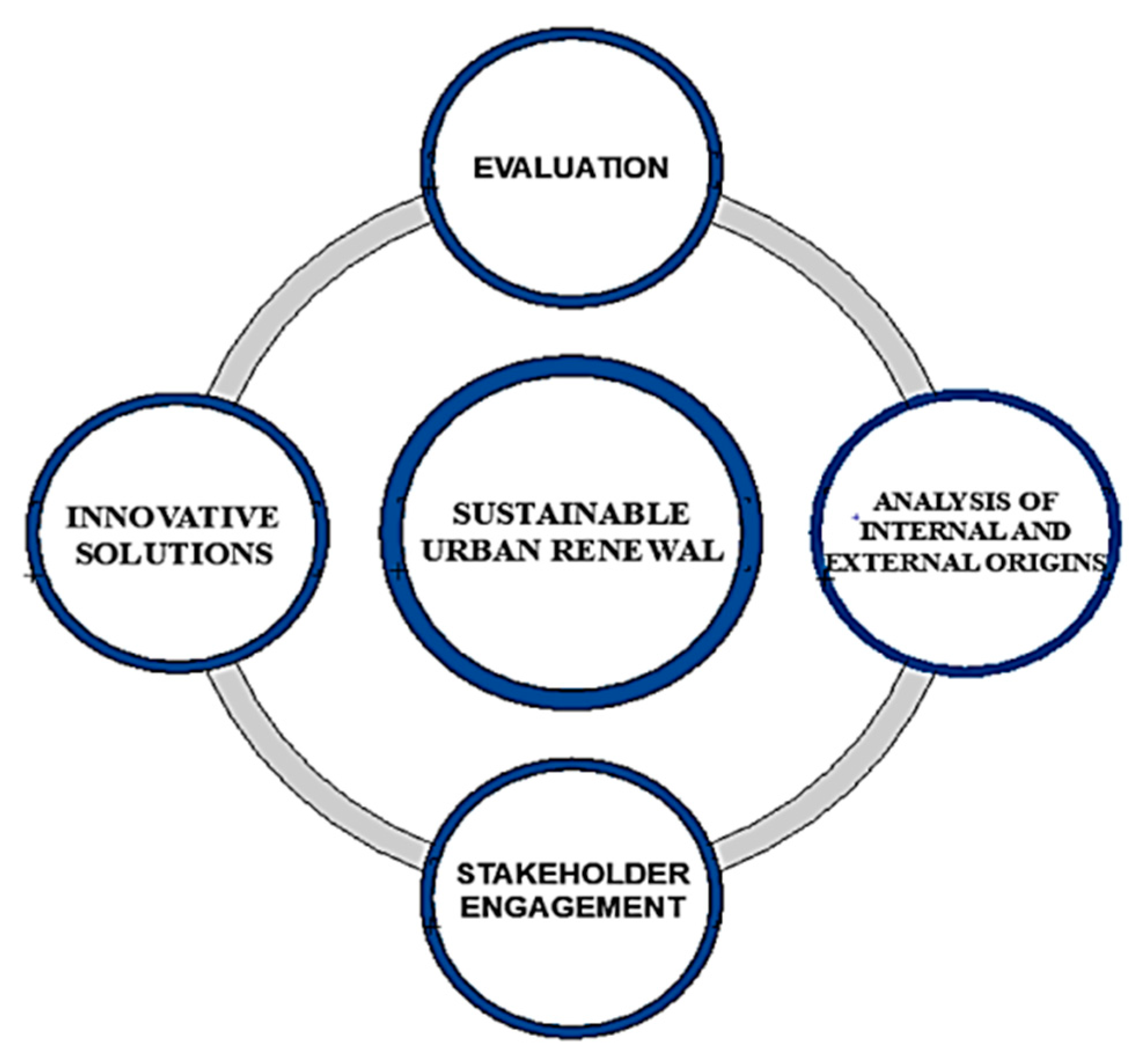
| Years | 2000 | 2001 | 2002 | 2003 | 2004 | 2005 | 2006 | 2007 | 2008 | 2009 | 2010 | 2011 | 2012 | 2013 | 2014 | 2015 | 2016 | 2017 | 2018 | 2019 | 2020 |
|---|---|---|---|---|---|---|---|---|---|---|---|---|---|---|---|---|---|---|---|---|---|
| Journal | 98 | 103 | 96 | 101 | 95 | 106 | 93 | 100 | 116 | 138 | 167 | 202 | 181 | 218 | 218 | 258 | 289 | 284 | 394 | 454 | 113 |
| Rank | Journal | 2000–2002 | 2003–2005 | 2006–2008 | 2009–2011 | 2012–2014 | 2015–2017 | 2018–2020 |
|---|---|---|---|---|---|---|---|---|
| 01 | Cities | 21 | 7 | 15 | 16 | 25 | 43 | 57 |
| 02 | Urban Studies | 17 | 30 | 18 | 30 | 25 | 19 | 10 |
| 03 | Sustainable Cities Additionally, Society | X | X | X | 2 | 5 | 15 | 83 |
| 04 | Journal Of Urban History | 8 | 4 | 5 | 21 | 16 | 19 | 11 |
| 05 | PloS ONE | X | X | X | 3 | 20 | 32 | 28 |
| Source Title | Tp | Tp (%) | IF(2018) | H Index | Country |
|---|---|---|---|---|---|
| Cities | 184 | 4.63 | 3.853 | 81 | United Kingdom |
| Urban Studies | 149 | 3.75 | 3.272 | 138 | United Kingdom |
| Sustainable Cities and Society | 105 | 2.64 | 4.624 | 43 | The Netherlands |
| Journal of Urban History | 84 | 2.11 | 0.339 | 24 | USA |
| PloS ONE | 83 | 2.10 | 2.776 | 300 | USA |
| Habitat International | 65 | 1.63 | 3.846 | 69 | United Kingdom |
| International Journal of Urban and Regional Research | 59 | 1.48 | 2.768 | 105 | United Kingdom |
| Journal of Cleaner Production | 57 | 1.43 | 6.395 | 173 | The Netherlands |
| Land Use Policy | 54 | 1.35 | 2.143 | 103 | The Netherlands |
| European Planning Studies | 51 | 1.28 | 2.101 | 75 | United Kingdom |
| Affiliation | TP 1 | TRP (%) 2 | Country |
|---|---|---|---|
| Chinese Academy of Sciences | 65 | 1.64 | China |
| Delft University of Technology | 63 | 1.58 | The Netherlands |
| The University of Hong Kong | 54 | 1.34 | China |
| Hong Kong Polytechnic University | 48 | 1.20 | China |
| UCL | 38 | 0.95 | United Kingdom |
| Arizona State University | 33 | 0.83 | United Kingdom |
| The University of Manchester | 32 | 0.80 | United Kingdom |
| The University of Toronto | 32 | 0.80 | Canada |
| OTB - Onderzoek Voor de Gebouwde Omgeving, TU Delft | 32 | 0.80 | United Kingdom |
| The University of Melbourne | 31 | 0.78 | Australie |
| The Universiteit Van Amsterdam | 30 | 0.75 | United Kingdom |
| The University of the Glasgow | 29 | 0.73 | United Kingdom |
| University of Birmingham | 26 | 0.65 | United Kingdom |
| Newcastle University | 25 | 0.62 | United Kingdom |
| CNRS | 24 | 0.60 | France |
| Years | 2000 | 2001 | 2002 | 2003 | 2004 | 2005 | 2006 | 2007 | 2008 | 2009 | 2010 | 2011 | 2012 | 2013 | 2014 | 2015 | 2016 | 2017 | 2018 | 2019 | 2020 |
|---|---|---|---|---|---|---|---|---|---|---|---|---|---|---|---|---|---|---|---|---|---|
| Annual quote | 2786 | 2522 | 3149 | 3559 | 3805 | 5269 | 4042 | 3779 | 3537 | 3207 | 4099 | 5460 | 4227 | 5428 | 4300 | 4371 | 4619 | 3988 | 3102 | 1698 | 165 |
| Annual quote % | 3.61 | 3.27 | 4.08 | 4.61 | 4.93 | 6.83 | 5.24 | 4.9 | 4.58 | 4.15 | 5.32 | 7.08 | 5.48 | 7.04 | 5.58 | 5.67 | 5.99 | 5.17 | 4.02 | 2.20 | 0.21 |
| Years | Annual Quote | Papers | Journal | Citation | Author | Ref |
|---|---|---|---|---|---|---|
| 2004 | 4.93 | The role of urban parks for the sustainable city | Landscape and Urban Planning | 1043 | Anna Chiesura | [36] |
| 2006 | 5.24 | Urbanization in developing countries: Current trends, future projections, and key challenges for sustainability | Technology in Society | 729 | Cohen, B. | [37] |
| 2016 | 5.98 | Supilinn, Tartu—The lively vernacular against urban renewal: A Lefebvrean critique | Space and Culture | 646 | Nutt, N.; Hiob, M.; Kotval, Z. | [43] |
| 2007 | 4.90 | The changing metabolism of cities | Journal of Industrial Ecology | 630 | Kennedy, C.; Cuddihy, J.; Engel-Yan, J. | [46] |
| 2005 | 6.83 | Rethinking sustainable cities: Multilevel governance and the ‘urban’ politics of climate change | Environmental Politics | 569 | Bulkeley, H., | [49] |
| 2005 | 6.83 | A SWOT analysis of the field of virtual reality rehabilitation and therapy | Presence: Teleoperators and Virtual Environments | 484 | Rizzo, A. | [50] |
| 2005 | 6.83 | The compact city fallacy | Journal of Planning Education and Research | 409 | Neuman, M. | [51] |
Publisher’s Note: MDPI stays neutral with regard to jurisdictional claims in published maps and institutional affiliations. |
© 2021 by the authors. Licensee MDPI, Basel, Switzerland. This article is an open access article distributed under the terms and conditions of the Creative Commons Attribution (CC BY) license (https://creativecommons.org/licenses/by/4.0/).
Share and Cite
Zheng, B.; Masrabaye, F.; Guiradoumngué, G.M.; Zheng, J.; Liu, L. Progress in Research on Sustainable Urban Renewal Since 2000: Library and Visual Analyses. Sustainability 2021, 13, 4154. https://doi.org/10.3390/su13084154
Zheng B, Masrabaye F, Guiradoumngué GM, Zheng J, Liu L. Progress in Research on Sustainable Urban Renewal Since 2000: Library and Visual Analyses. Sustainability. 2021; 13(8):4154. https://doi.org/10.3390/su13084154
Chicago/Turabian StyleZheng, Bohong, Francis Masrabaye, Gerald Madjissembaye Guiradoumngué, Jian Zheng, and Linlin Liu. 2021. "Progress in Research on Sustainable Urban Renewal Since 2000: Library and Visual Analyses" Sustainability 13, no. 8: 4154. https://doi.org/10.3390/su13084154
APA StyleZheng, B., Masrabaye, F., Guiradoumngué, G. M., Zheng, J., & Liu, L. (2021). Progress in Research on Sustainable Urban Renewal Since 2000: Library and Visual Analyses. Sustainability, 13(8), 4154. https://doi.org/10.3390/su13084154







